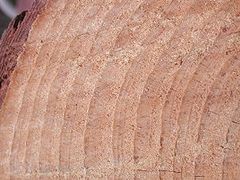
Nutrition
Like all members
of Kingdom Plantae, P. pungens is autotrophic, meaning it can
create its own e nergy; it is unnecessary for it to consume other species. This
organism is more specifically known as being photosynthetic.
Photosynthesis is the process by which plants use energy from the sun to
produce sugar. The reaction uses water (H2O), carbon dioxide
(CO2) and sunlight to produce sugar (C6H12O6)
and oxygen (O2) seen here:
nergy; it is unnecessary for it to consume other species. This
organism is more specifically known as being photosynthetic.
Photosynthesis is the process by which plants use energy from the sun to
produce sugar. The reaction uses water (H2O), carbon dioxide
(CO2) and sunlight to produce sugar (C6H12O6)
and oxygen (O2) seen here:
Sunlight + 6H2O + 6CO2
à C6H12O6
+ O2
The
tree gets the necessary water from the ground, which it absorbs through
its roots. Carbon dioxide is taken from the atmosphere by its leaves. Even more specifically, the CO2 gas is transported across the
cell wall by the stomata (or stomatal lines).
Even more specifically, the CO2 gas is transported across the
cell wall by the stomata (or stomatal lines). Finally the energy required for the reaction
comes from the sun
in the form of solar power. To take in light from the sun, plants use
chloroplasts with specialized green pigments called chlorophyll to
convert unusable energy from the sun into chemical energy that they can
use to fuel the photosynthesis reaction. This produces oxygen (what we
breathe) and glucose (sugar) for the plant. Plants take this sugar and
through cellular respiration generate energy (ATP). All plants,
including the Blue Spruce store their food as starch.
Finally the energy required for the reaction
comes from the sun
in the form of solar power. To take in light from the sun, plants use
chloroplasts with specialized green pigments called chlorophyll to
convert unusable energy from the sun into chemical energy that they can
use to fuel the photosynthesis reaction. This produces oxygen (what we
breathe) and glucose (sugar) for the plant. Plants take this sugar and
through cellular respiration generate energy (ATP). All plants,
including the Blue Spruce store their food as starch.
Specialized structures within the spruce’s trunk allow for transport of
this sugar, glucose, as well as water and many other substances. Vascular
tissues called
xylem and phloem (or
click here),
usually found together, help move sugars, water and other nutrients up,
down,
 and to every part of the tree. To generalize the structures of
each, the xylem moves water and nutrients up the trunk to the top of the
tree and everywhere else necessary. The phloem moves sugars down to the
roots and places in between. Moving water up, against the force of
gravity is not an easy task. Here are a few properties of water that are
vital to the UPWARD transport through the tree: water moves from an area of high
water potential (low concentration) to low water potential (high
concentration), water molecules are highly polarized and have a tendency
to attach to one another (cohesion), and water molecules have a high
affinity for other polar molecules (adhesion). Now, the question is, how
does water get to the tops of trees? Water evaporating from leaves
(transpiration) creates a lowered water potential of the mesophyll cells
of the leaf.
and to every part of the tree. To generalize the structures of
each, the xylem moves water and nutrients up the trunk to the top of the
tree and everywhere else necessary. The phloem moves sugars down to the
roots and places in between. Moving water up, against the force of
gravity is not an easy task. Here are a few properties of water that are
vital to the UPWARD transport through the tree: water moves from an area of high
water potential (low concentration) to low water potential (high
concentration), water molecules are highly polarized and have a tendency
to attach to one another (cohesion), and water molecules have a high
affinity for other polar molecules (adhesion). Now, the question is, how
does water get to the tops of trees? Water evaporating from leaves
(transpiration) creates a lowered water potential of the mesophyll cells
of the leaf. Due to the increased concentration of ions in the leaves,
water from the high potential xylem moves into the low potential mesophyll cells. This reduces pressure in the xylem, which in turn draws
water into the vessels. Adhesion and cohesion keep the chain from
breaking and do not allow water molecules to detach from one another as
they move up the trunk. Roots soak up water from the soil using this
very same idea of water potential.
Due to the increased concentration of ions in the leaves,
water from the high potential xylem moves into the low potential mesophyll cells. This reduces pressure in the xylem, which in turn draws
water into the vessels. Adhesion and cohesion keep the chain from
breaking and do not allow water molecules to detach from one another as
they move up the trunk. Roots soak up water from the soil using this
very same idea of water potential.
The Colorado Blue Spruce is quite tolerant to adverse conditions.
It prefers moist, acidic soils, but can withstand dry soil, variant pH,
and even winter salt spray, which makes it desirable for growth in
colder climates.
